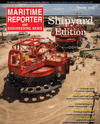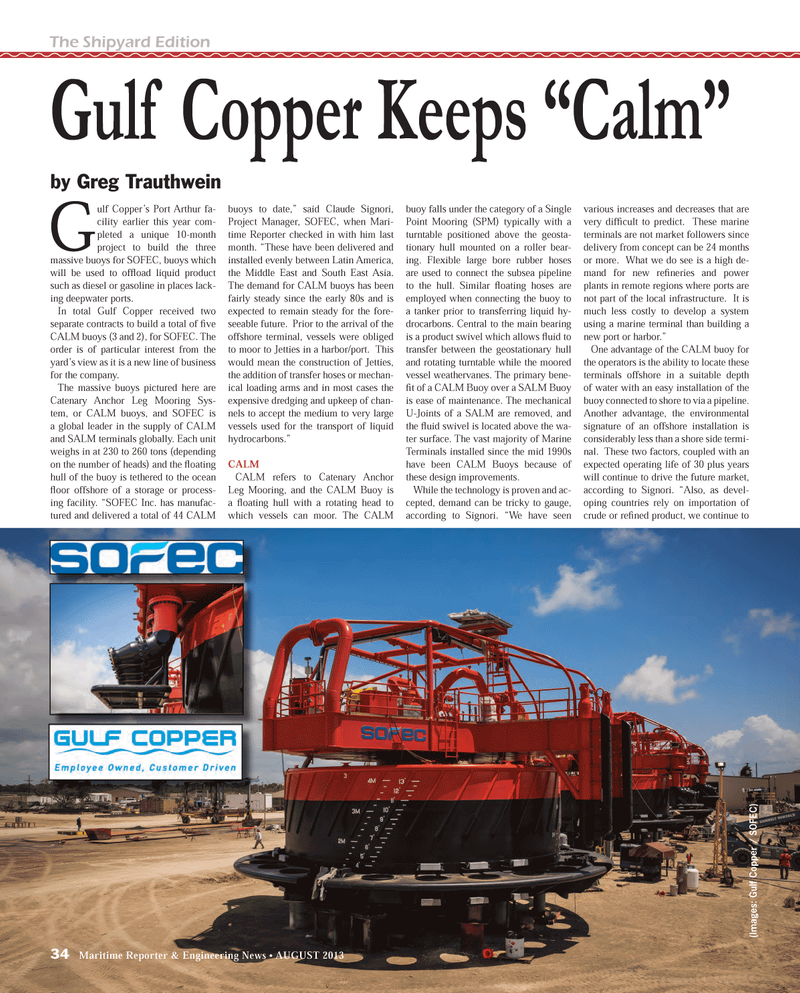
Page 34: of Maritime Reporter Magazine (August 2013)
Shipyard Edition
Read this page in Pdf, Flash or Html5 edition of August 2013 Maritime Reporter Magazine
34 Maritime Reporter & Engineering News ? AUGUST 2013 Gulf Copper?s Port Arthur fa- cility earlier this year com-pleted a unique 10-month project to build the three massive buoys for SOFEC, buoys which will be used to ofß oad liquid product such as diesel or gasoline in places lack-ing deepwater ports. In total Gulf Copper received two separate contracts to build a total of Þ ve CALM buoys (3 and 2), for SOFEC. The order is of particular interest from the yard?s view as it is a new line of business for the company. The massive buoys pictured here are Catenary Anchor Leg Mooring Sys- tem, or CALM buoys, and SOFEC is a global leader in the supply of CALM and SALM terminals globally. Each unit weighs in at 230 to 260 tons (depending on the number of heads) and the ß oating hull of the buoy is tethered to the ocean ß oor offshore of a storage or process- ing facility. ?SOFEC Inc. has manufac- tured and delivered a total of 44 CALM buoys to date,? said Claude Signori, Project Manager, SOFEC, when Mari- time Reporter checked in with him last month. ?These have been delivered and installed evenly between Latin America, the Middle East and South East Asia. The demand for CALM buoys has been fairly steady since the early 80s and is expected to remain steady for the fore-seeable future. Prior to the arrival of the offshore terminal, vessels were obliged to moor to Jetties in a harbor/port. This would mean the construction of Jetties, the addition of transfer hoses or mechan-ical loading arms and in most cases the expensive dredging and upkeep of chan-nels to accept the medium to very large vessels used for the transport of liquid hydrocarbons.?CALMCALM refers to Catenary Anchor Leg Mooring, and the CALM Buoy is a ß oating hull with a rotating head to which vessels can moor. The CALM buoy falls under the category of a Single Point Mooring (SPM) typically with a turntable positioned above the geosta-tionary hull mounted on a roller bear- ing. Flexible large bore rubber hoses are used to connect the subsea pipeline to the hull. Similar ß oating hoses are employed when connecting the buoy to a tanker prior to transferring liquid hy-drocarbons. Central to the main bearing is a product swivel which allows ß uid to transfer between the geostationary hull and rotating turntable while the moored vessel weathervanes. The primary bene- Þ t of a CALM Buoy over a SALM Buoy is ease of maintenance. The mechanical U-Joints of a SALM are removed, and the ß uid swivel is located above the wa- ter surface. The vast majority of Marine Terminals installed since the mid 1990s have been CALM Buoys because of these design improvements.While the technology is proven and ac-cepted, demand can be tricky to gauge, according to Signori. ?We have seen various increases and decreases that are very difÞ cult to predict. These marine terminals are not market followers since delivery from concept can be 24 months or more. What we do see is a high de- mand for new reÞ neries and power plants in remote regions where ports are not part of the local infrastructure. It is much less costly to develop a system using a marine terminal than building a new port or harbor.? One advantage of the CALM buoy for the operators is the ability to locate these terminals offshore in a suitable depth of water with an easy installation of the buoy connected to shore to via a pipeline. Another advantage, the environmental signature of an offshore installation is considerably less than a shore side termi-nal. These two factors, coupled with an expected operating life of 30 plus years will continue to drive the future market, according to Signori. ?Also, as devel-oping countries rely on importation of crude or reÞ ned product, we continue to Gulf Copper Keeps ?Calm? The Shipyard Editionby Greg Trauthwein (Images: Gulf Copper / SOFEC)MR #8 (34-41).indd 34MR #8 (34-41).indd 348/1/2013 9:35:30 AM8/1/2013 9:35:30 AM

 33
33

 35
35
